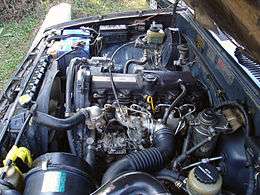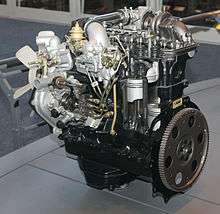Toyota L engine
The L family first appeared in October 1977, it is a series of inline four-cylinder diesel engines. It is the first diesel engine from Toyota to use a rubber timing belt in conjunction with a SOHC head. Engines like 2L-II and 2L-T are still in production to the present day. In Gibraltar, 5L-E engine are still used in Eighth-generation Toyota Hilux and Second-generation Toyota Fortuner.[2][3] Vehicles with the diesel engine were exclusive to Toyota Japan dealership locations called Toyota Diesel Store locations until the sales channel was disbanded in 1988.[4]
| Toyota L engine | |
|---|---|
 | |
| Overview | |
| Manufacturer | Toyota Motor Corporation |
| Production | 1977–present |
| Layout | |
| Configuration | Inline 4 |
| Displacement | 2.2–3.0 L (2,188–2,986 cc) |
| Valvetrain | SOHC 2 valves x cyl. |
| Combustion | |
| Fuel system | Indirect injection[1], Electronic fuel injection (2L-TE, 2L-THE, 5L-E) |
| Fuel type | Diesel |
| Cooling system | Water-cooled |
| Output | |
| Power output | 72–104 hp (54–78 kW; 73–105 PS) |
| Torque output | 12.9–22.5 kg⋅m (127–221 N⋅m; 93–163 lb⋅ft) |
| Chronology | |
| Successor | Toyota KD engine |
L
The L is the first L engine produced. Note: Toyota just calls it the L engine, not the 1L engine. 2.2 L (2,188 cc), four-cylinder diesel engine. Output is 72 PS (53 kW; 71 hp) at 4200 rpm and 12.9 kg⋅m (127 N⋅m; 93 lb⋅ft) of torque or 14.5 kg⋅m (142 N⋅m; 105 lb⋅ft) JIS. Applications:
2L
The 2L is a 2.4 L (2,446 cc) 4-cylinder diesel engine. Bore and stroke is 92 mm × 92 mm (3.62 in × 3.62 in), with a compression ratios of around 22.3:1 and redline of 4800 rpm. Outputs range from 76 to 87 PS (56 to 64 kW; 75 to 86 hp) and torque of 15.8–16.8 kg⋅m (155–165 N⋅m; 114–122 lb⋅ft).
Applications:
- Mark II/Chaser/Cresta/Cressida (85 PS (63 kW; 84 hp) gross at 4,200 rpm, 16.8 kg⋅m (165 N⋅m; 122 lb⋅ft) gross at 2400 rpm, 22.2:1)[5]
- Revo
- Hiace
- Hilux (83 hp (62 kW; 84 PS) gross at 4000 rpm, 16.8 kg⋅m (165 N⋅m; 122 lb⋅ft) gross at 2200 rpm, 22.3:1)
- Dyna
- Kijang Fourth Generation
- 1984–1990 Blizzard LD20 (76 PS (56 kW; 75 hp) net at 4000 rpm, 15.7 kg⋅m (154 N⋅m; 114 lb⋅ft) net at 2400 rpm, 22.3:1)[6]
2L-II

The 2L-II is an upgrade of the 2L. Bore and stroke remains the same. The most significant change is that the camshaft lifts the valve directly via tappet instead of a rocker arm. The valve clearance is adjusted using shims. Later L engines (3L and 5L) also use this method of valve operation. Maximum output is 89 hp (66 kW; 89 hp) gross at 4200 rpm and maximum torque is 15.2 kg⋅m (149 N⋅m; 110 lb⋅ft) net or 17 kg⋅m (167 N⋅m; 123 lb⋅ft) gross at 2400 rpm.
Applications:
- Hiace
- Hilux
2L-T
The 2L-T is a 2.4 L (2,446 cc) turbo version of the 2L still being produced since 1985. The bore and stroke are the same but the 2L-T has a compression ratio of 20:1. Output is 85 to 91 PS (63 to 67 kW; 84 to 90 hp) gross at 4000 rpm with 19.2 kg⋅m (188 N⋅m; 139 lb⋅ft) gross of torque at 2200 rpm.
Applications:
- Hilux
- Mark II GL Saloon
- Cresta Super Custom
- Land Cruiser (70 Series)
- 1984–1990 Blizzard LD20 (85 PS (63 kW; 84 hp) at 4000 rpm, 19.2 kg⋅m (188 N⋅m; 139 lb⋅ft), 20.0:1)[6]
- 2000–2006 Metrocab TTT 67 kW (90 hp; 91 PS)[7]
2L-T II
The 2L-T II is an upgrade of the 2L-T. Of the same dimensions as all other 2L engines, the most significant change is that the camshaft lifts the valve directly via tappet instead of a rocker arm. The valve clearance is adjusted using shims. Compression rate is also 20:1. Output is 94 PS (69 kW; 93 hp) at 4000 rpm, 22 kg⋅m (216 N⋅m; 159 lb⋅ft) at 2400 rpm[8]
Applications:
2L-TE

Developed as a new version of 2L-T, the 2L-TE features a new development used in diesel engines at that time, the EFI (Electronic Fuel Injection) system. Although Toyota used this fuel injection system in gasoline engines years before, this is among the first diesel engines to adopt such a system. Although the basic construction is similar to a modern gasoline injector, the EFI system in 2L-TE utilize considerably higher injection pressures. The EFI system meter fuel with great precision and succeeded in increasing the engine's efficiency. Like the 2L-T, it is 2.4 L (2,446 cc) and it is a SOHC (Single Overhead Cam) engine, having 8 valves. It also comes with a Turbo charger. The bore and stroke is 92 mm × 92 mm (3.62 in × 3.62 in). Due to the EFI system, the 2L-TE develops significantly more torque than its predecessor. Maximum horsepower is 97 PS (71 kW; 96 hp) at 3800 rpm and maximum torque is 22.5 kg⋅m (221 N⋅m; 163 lb⋅ft) at 2400 rpm. Redline of this engine is at 4800 rpm. Compression ratio is 21.0:1, slightly higher than 2L-T. 2L-TE was largely replaced by the KZ engine in 1993, although it continued to be used in some models until 2000.
Applications:
- Toyota Crown LS130/LS131
- 1993.08 - 1995.12 Toyota Crown LS141
- Toyota Hiace
- Hilux/Hilux Surf/4Runner
- Land Cruiser Prado LJ70
- Mark II/Chaser/Cresta
2L-THE
The High Pressure turbocharged version of 2L-TE features ceramic chambers. The fuel is injected with a high pressure system. Bore and stroke remains the same, 92 mm × 92 mm (3.62 in × 3.62 in) for both. Maximum output was 94–105 PS (69–77 kW; 93–104 hp) at 4000 rpm and maximum torque was 20.5–22.5 kg⋅m (201–221 N⋅m; 148–163 lb⋅ft). Compression ratio remains the same, 21.0:1. Comes with a Turbo charger and used the EFI (Electronic Fuel Injection) system as well.
Applications:
- 7th generation Crown (LS120/120G/120W)
- 8th generation Crown (LS130/131/130G/130W) with automatic transmission:
- 100 PS (74 kW; 99 hp) at 4000 rpm, 22.5 kg⋅m (221 N⋅m; 163 lb⋅ft) at 2400 rpm (AT)[8]
- 1991.10 - 1993.08, 9th generation Toyota Crown hardtop (LS141)
3L
The 3L is a 2.8 L (2,779 cc) four-cylinder diesel engine. Bore and stroke is 96 mm × 96 mm (3.78 in × 3.78 in), with a compression ratio of 22.2:1. Output is 91 PS (67 kW; 90 hp) gross at 4000 rpm with 19.2 kg⋅m (188 N⋅m; 139 lb⋅ft) gross of torque at 2400 rpm.
- Hilux/Hilux Surf/4Runner[9]
- Toyota HiAce
- Toyota Land Cruiser Prado (J90)
- Toyota Dyna 150 (Euro-spec)
5L
The 5L is a 3.0 L (2,986 cc) four-cylinder diesel engine. Bore and stroke is 99.5 mm × 96 mm (3.92 in × 3.78 in), with a compression ratio of 22.2:1. Output is 97 hp (72 kW; 98 PS) gross at 4000 rpm with 19.6 kg⋅m (192 N⋅m; 142 lb⋅ft) gross of torque at 2400 rpm.
5L-E
The 5L-E is a 3.0 L (2,986 cc) EFI version of the 5L engine. It is the latest member of the L family. It has a bore and stroke of 99.5 mm × 96 mm (3.92 in × 3.78 in), with a compression ratio of 22.2:1. Output (as fitted to the Hilux) is 78 kW (106 PS; 105 hp) gross at 4200 rpm with 20.1 kg⋅m (197 N⋅m; 145 lb⋅ft) gross of torque at 2200 rpm.[10] Power output varies according to fitment. The engine number is found on the top face of the block at the front of the engine.
Applications:
- Toyota Hilux
- Toyota Land Cruiser Prado (J90, J120, J150)
- Toyota Hiace (fifth generation, H200-series)
- Toyota Condor
- Toyota Fortuner
- Toyota Crown Comfort
See also
References
- "Toyota 2L engine specs".
- "Toyota Fortuner - Toyota Gibraltar Stockholdings Ltd".
- "Toyota Hilux - Toyota Gibraltar Stockholdings Ltd".
- Toyota L Engine (diesel) Repair Manual. Toyota Motor Sales Co. 1982.
- Büschi, Hans U., ed. (March 1991). Automobil Revue 1991. 86. Berne, Switzerland: Hallwag AG. p. 579. ISBN 3-444-00514-8.
- Automobil Revue 1991, p. 583
- "Metrocab TTT brief specification" (PDF). Archived from the original (PDF) on 2011-07-22.
- Automobil Revue 1991, p. 581
- Automobil Revue 1991, p. 588
- McCamish, Brian. "Toyota Hilux Engines". Retrieved 2010-01-15.
| Wikimedia Commons has media related to Toyota L engines. |